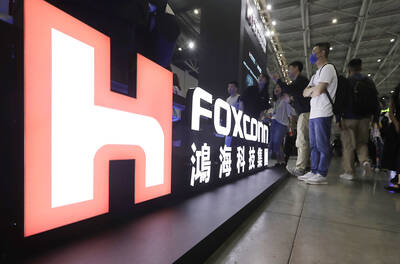With lower rate plans and a Skype-like feature to be launched in September, the Taipei City Government is hoping more users will sign up for its wireless service, or Wifly, by the end of the year.
There will be new plans offering users lower rates in terms of pay per minute, said Chang Sheng (張聖), vice president of the wireless business group at Q-ware Systems and Services Corp (安源資訊), the contractor of the Wifly project.
Infrequent use
"Some users are not using the service that frequently, which has prompted us to introduce the cheaper plans to enlarge our user base," he said at an event yesterday at which Taipei Mayor Ma Ying-jeou (
The new rates will be offered for prepaid services, and users can expect to pay less than NT$0.9 per minute, Chang said.
Free trials of Wifly ended in January, and users currently pay either NT$399 per month as a subscriber, or prepaid rates of NT$500 a month or NT$100 a day.
Wifly users will also be able to enjoy a new Internet phone feature similar to the popular Skype service, which allows users to make calls for free, or at a cheaper rate compared with those of telecommunications operators.
"Internet phone service occupies less broadband bandwidth and will entice users given the lower call rates," Chang added.
90 percent coverage
With the Taipei Arena now offering wireless service, around 90 percent of Taipei's population will be covered by Wifly by the end of next month, which is seven months behind the initial target.
The wireless initiative began with free trials in September 2004 and is part of the government's "M-City" (mobile city) project, which aims to turn Taipei into a wireless city. Total investment in the project is now at more than NT$1 billion (US$30.6 million).
With a wireless connection, residents can access the Web through their laptops or personal digital assistants, and can save on phone charges if they use Wi-Fi phones to make calls through the Internet.
The first phase of the Wifly project was concluded in January last year, covering 30 mass rapid transit (MRT) stations and their neighborhoods, which translated into wireless coverage for 20 percent of the city's population.
The second phase, which was completed in December last year, expanded that coverage to 50 percent of the population, including major business areas such as the Xinyi, Ximending and Dunhua districts, as well as underground malls connected to MRT stations.
By the end of the year, the government intends to attract at least 200,000 subscribers to its service, up from the current 32,000.
Better marketing
To meet the target, one analyst said that the government would need to boost its marketing to make users more aware of the wide Wifly coverage.
As not many households are choosing to set up wireless access points at home, lower rates for Wifly service will prompt more users to opt for the service, according to Simon Yang (
"NT$0.9 is a reasonable benchmark rate for Internet service providers, and is still within the range where they can make a profit. But if rates could be slashed by half in the future, making it cheaper than the current price for household broadband, more people will be willing to go for it," he added.

A proposed 100 percent tariff on chip imports announced by US President Donald Trump could shift more of Taiwan’s semiconductor production overseas, a Taiwan Institute of Economic Research (TIER) researcher said yesterday. Trump’s tariff policy will accelerate the global semiconductor industry’s pace to establish roots in the US, leading to higher supply chain costs and ultimately raising prices of consumer electronics and creating uncertainty for future market demand, Arisa Liu (劉佩真) at the institute’s Taiwan Industry Economics Database said in a telephone interview. Trump’s move signals his intention to "restore the glory of the US semiconductor industry," Liu noted, saying that

On Ireland’s blustery western seaboard, researchers are gleefully flying giant kites — not for fun, but in the hope of generating renewable electricity and sparking a “revolution” in wind energy. “We use a kite to capture the wind and a generator at the bottom of it that captures the power,” said Padraic Doherty of Kitepower, the Dutch firm behind the venture. At its test site in operation since September 2023 near the small town of Bangor Erris, the team transports the vast 60-square-meter kite from a hangar across the lunar-like bogland to a generator. The kite is then attached by a

Foxconn Technology Co (鴻準精密), a metal casing supplier owned by Hon Hai Precision Industry Co (鴻海精密), yesterday announced plans to invest US$1 billion in the US over the next decade as part of its business transformation strategy. The Apple Inc supplier said in a statement that its board approved the investment on Thursday, as part of a transformation strategy focused on precision mold development, smart manufacturing, robotics and advanced automation. The strategy would have a strong emphasis on artificial intelligence (AI), the company added. The company said it aims to build a flexible, intelligent production ecosystem to boost competitiveness and sustainability. Foxconn

STILL UNCLEAR: Several aspects of the policy still need to be clarified, such as whether the exemptions would expand to related products, PwC Taiwan warned The TAIEX surged yesterday, led by gains in Taiwan Semiconductor Manufacturing Co (TSMC, 台積電), after US President Donald Trump announced a sweeping 100 percent tariff on imported semiconductors — while exempting companies operating or building plants in the US, which includes TSMC. The benchmark index jumped 556.41 points, or 2.37 percent, to close at 24,003.77, breaching the 24,000-point level and hitting its highest close this year, Taiwan Stock Exchange (TWSE) data showed. TSMC rose NT$55, or 4.89 percent, to close at a record NT$1,180, as the company is already investing heavily in a multibillion-dollar plant in Arizona that led investors to assume